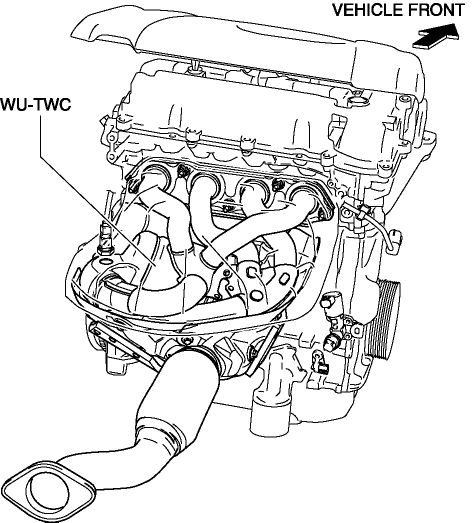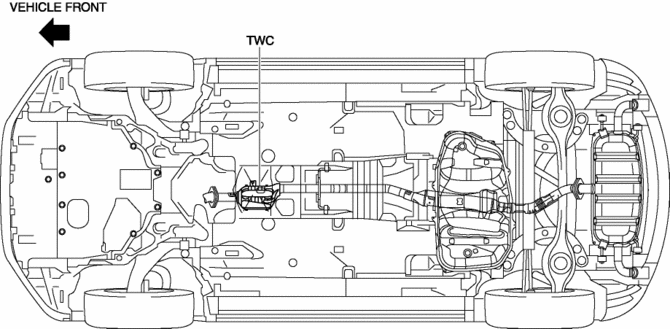Mazda CX-5 Service & Repair Manual: Catalytic Converter
Purpose, Function
-
Purifies contaminants in the exhaust gas by utilizing the chemical reactions of the three-way catalytic converter.
-
A WU-TWC and a TWC have been adopted.
-
The three-way catalyst is integrated with the exhaust manifold.
-
Because the catalyst receives the high temperature exhaust gas just after the gas is exhausted, it activates quickly and achieves an improved purification performance.
-
A single-nano catalyst has been adopted in which the purification performance can be maintained using less precious metal materials than conventional catalysts.
-
WU-TWC
-
TWC
Construction
WU-TWC
-
The WU-TWC is installed to the rear of the engine.

-
The WU-TWC is integrated with the exhaust manifold.
TWC
-
The TWC is installed to the rear of the WU-TWC.
2WD

AWD

-
A single-nano catalyst has been adopted for the under-floor three-way catalyst. With a conventional three-way catalyst, the precious metals move and agglutinate to each other by the heat of the exhaust gas because they are structured such that they adhere on catalyst material. Therefore, it was necessary to use a large amount of precious metal because it is estimated that the purification performance lowers due to the decrease in the surface area of the precious metals. The single-nano catalyst is structured such that it embeds small precious metal particles into the catalyst material. Because the precious metal particles do not agglutinate on the surface of the three-way catalyst, it can maintain superior purification performance using less precious metal than the conventional system.

Operation
-
Contaminants in the exhaust gas (HC, CO, NOx) are purified by oxidization and deoxidization while they are passing through the catalytic converter.
-
Oxidization process
-
Noxious hydrocarbon (HC) and carbon monoxide (CO) are bound with oxygen and converted to non-noxious carbon dioxide and water.
O2+HC+CO>CO2+H2O
-
Deoxidization process
-
Noxious nitrogen oxide (NOx) is converted to non-noxious nitrogen and oxygen. A part of the oxygen generated in this process is used in the oxidization process.
NOx>N2+O2
 Canister Vent (Cv) Solenoid Valve
Canister Vent (Cv) Solenoid Valve
U.S.A. And CANADA
Purpose, function
Seals the atmosphere side of the charcoal canister during EVAP leak check
monitoring.
Construction
Included in the charcoal canister.
...
 Catch Tank Inspection
Catch Tank Inspection
1. Remove the catch tank..
2. Plug the purge solenoid valve side into the catch tank.
3. Inspect for air leakage when blowing air using your mouth into the charcoal
canister side.
If ...
Other materials:
Fuel Gauge Sender Unit Removal/Installation [2 Wd]
WARNING:
Always keep sparks and flames away from fuel when servicing the fuel system.
Fuel can be easily ignited which could cause serious injury or death, and damage
to equipment.
Fuel line spills and leakage from the pressurized fuel system are dangerous.
Fuel can ignite a ...
Rear Spoiler Removal/Installation
Removal
WARNING:
Using a utility knife with bare hands can cause injury. Always wear gloves
when using a utility knife.
1. Remove the liftgate upper trim.
2. Remove caps A.
3. Remove nuts B.
4. Attach a piece of wire between the liftgate striker and liftgate latch to
ho ...
Clutch Cover Inspection [C66 M R]
1. Remove the clutch cover..
2. Perform the following procedures to inspect the clutch cover.
If it exceeds the maximum specification, replace the clutch cover..
a. Measure the wear of the diaphragm spring fingers.
Clutch cover diaphragm spring fingers maximum depth
0.6 ...
